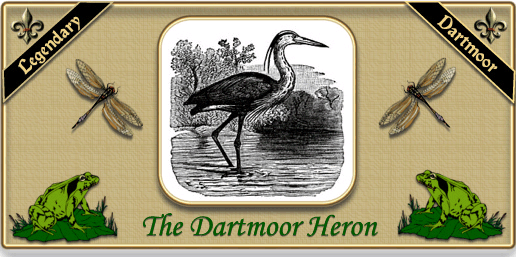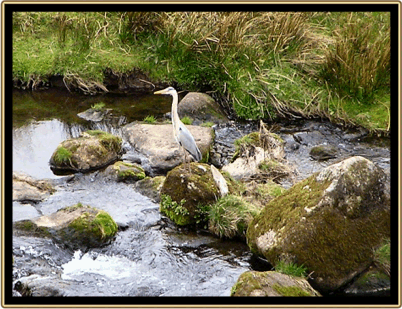
The woodcock now upon the wing
Is flitting past to upland spring;
The fern owl wheels above the brake,
The heron screams from yonder lake;
The Dart is moaning down the dell,
Like music from a muffled bell.
Quite often you can be strolling alongside a moorland river or a leat when a huge form will slowly lift itself into the air and then gracefully flap off into the distance. You have just disturbed ‘Old Nog’ the grey heron who was probably out searching for his breakfast. Various writers have described the solitary feeding of the heron and some have portrayed the lonely waste of the moor that is dotted with, “heron haunted pools”. Ardea cinerea, the Grey Heron has to be the largest bird to be found on Dartmoor and they can frequently be seen almost anywhere, especially by the rivers, streams, leats and marshes. The bird is classified as a resident breeder and their nesting sites have been a common occurrence in the plantations. Herons tend to nest in colonies centred around tall trees, these are known as Heronries and in some cases on Dartmoor, a Cranery. This confusion has arisen because in some parts of the moor the heron was always known as a crane. To this end it is possible to find several place-names which refer specifically to the heron/crane;
| Name | OS Grid Ref | Also Known As |
| ARCHERTON HERONRY | SX 635 780 | |
| CRANBROOK | SX 745 888 | |
| CRANERY BOTTOM | SX 656 770 | |
| CRANERY BROOK | SX 648 760 | AKA Bellever Combe Lake, Bellaford Combe Lake |
| CRANE HILL | SX 622 690 | AKA Crane tor |
| CRANE LAKE | SX 605 685 | AKA Maynard’s Stream |
| CRANE LAKE | SX 629 762 | AKA Smith Hill Brook |
| CRANE TOR | SX 622 690 | AKA Crane Hill |
| CRANERY, THE | SX 653 766 |
To the above list could be added Cranmere Pool but there is some debate as to whether it is the ‘mere of the crane’ or the ‘mere of the crow’. There have been or are heronries dotted around various places on the moor, these include; Venford Reservoir, Fernworthy Reservoir, Bellever Plantation, Soussons Plantation, Beardown Plantation, Baggator Plantation, Archerton, Buckfast, Chagford, Dunnabridge, Harford, Hexworthy, Holne, Meavy, Tor Royal and Wanford Wood (the places in green are current heronries). If these locations were plotted on the map it soon becomes obvious that they are mostly in central Dartmoor and in or near plantations or reservoirs. The cry of a heron is guaranteed to send as shiver down your back as it has to be the most blood curdling shriek which emanates from the avian world.
Water plays an important part in a heron’s life as it is the source of most of their food, this being fish, eels, frogs, small mammals such as water voles and small birds. Their method of hunting is one of patience, perseverance and pin-point accuracy. The bird will stand motionless with its neck kinked until an unsuspecting meal comes within striking distance. Then the heron will dart forward and stab its prey, sometimes several times until it floats on the surface when it will be greedily consumed. Herons will also stalk among the waterside vegetation where it will move slowly along searching for its prey which when found will be stabbed and gobbled.
Ever since trout and salmon fishing became popular on Dartmoor the poor heron came in for a great deal of ‘bad press’, so much so that at some years the various Fishing Boards were paying for them to be shot. It was considered that they were responsible for depleting the coveted fish stocks. In 1899 the Dart District Fishery Board Meeting reported that – “Lieutenant Colonel Daubeny wrote from Postbridge, calling attention to the increase in herons at Archerton. He had counted there recently. The destruction of fish by them must be enormous. In the interests of fishing some steps must be taken to keep the numbers within bounds, as the increase in these most destructive birds, unless dealt with quickly, would ruin the trout and salmon fishing. Mr. Pike said it would be illegal to shoot them. Mr. E. Tucker said water ousels were plentiful, and there was also a number of bull trout in the river. Mr. Tanner mentioned that there had been a heronry on the Moor ever since he had been a boy. He did not think they need trouble themselves about it. – no action was taken. ” In 1925 the Dart Fishery Board were paying five shillings a head for herons until they realised that it was illegal to shoot them between March 1st until August 1st. Accordingly they removed the bounty on herons and shifted it over to shags found nearer the coastal stretches of the Dart.
Typically an adult heron will stack up to between 90cm to 100cm and weighs in at an average of 1.5kg, the wingspan is roughly 175cm – 195cm. There appears to be a decline in heron numbers on Dartmoor, possibly due the the de-forestation of the plantations or a decline in the reservoir fish stock numbers.

Heron on the Blackbrook
Folklore-wise there is very little which relates to the heron, some say it’s bad luck to have a heron land in your garden. This probably is more applicable today than at any other time, especially if you have a stocked fishpond in the garden. You could say that a modern myth about the heron can be seen in any agricultural shop in the form of a plastic replica. The theory behind these things is that herons will never feed in close proximity of each other, ergo put a fake heron in your fish pond and all other herons will consider the pond as occupied. In Greek mythology the Heron was also considered to be ‘bad news’ because it always hunted in shallow water and this would indicate such to any invaders who were looking for a fording place. There is one story that was told in the Chagford area about the Heron and the Crow which came with a couplet;
“With evil people neither stay nor go;
The Heron died for being with the crow”.
This adage came from the story about how many years ago a heron and a crow were nesting together in a huge tree. One hot day a traveller came across the moor and on reaching the tree took advantage of the welcomed shade. Soon he was fast asleep and with mouth agape snored contentedly. So deep was his sleep that gradually the sun worked its way around the sky until the slumbering traveller was no longer in the shade. The heron spotted this and shuffled along a branch which stretched over the man and here he spread his mighty wings thus shading him. Having seen this act of kindness the wicked crow also shuffled along the branch, when he was directly above the gaping mouth of the traveller he dropped an acorn into it and then flew off. Immediately the man awoke and choked and spluttered until he coughed up the acorn, he then looked into the tree and saw the heron perched overhead. Without a second thought he drew his pistol and shot the heron dead which in his eyes was fair recompense for the bird nearly killing him. Another proverb which described a liar was; “Ee u’d ‘ave a man knaw that the moon be made of cheese and the cat took the crane“. Weather-wise it was said that when the heron flies low it is a sure sign of approaching rain and conversely when it flies high it’s a sign of fine weather. It is also said that when a heron wades upstream this too is a sign of good weather.
There can be no question that at one time the heron graced the dining tables of the rich and famous as the following recipe from the 1400s shows: “Take a heron; lete him blode as a crane, And serue him in al poyntes as a crane, in scalding, drawing, and kuttyng the bone of the nekke awey, And lete the skyn be on, & c.; roste him and sause him as be Crane; breke awey the bone fro the kne to the fote, And lete the skyn be on . . . his sauce is to be mynced with pouder of gynger, vynegre, & Mustard”.
The name ‘Old Nog’ comes from a heron who was a character who appeared in Henry Williamson’s book, Tarka the Otter. It has always fascinated me as to what the origins of the name were and why it should be given to a heron. Tír na nÓg, can be found in early Irish mythology and refers to the ‘Land of Eternal Youth’, nÓg being the ‘youth’ element, but why this should apply to a heron escapes me. The Old English word ‘nög‘ is an adjective meaning ‘enough’ or ‘abundant’, both are not representative of a heron. An internet search for the mane simply reveals the egg nog drink and some hideous dwarf from Star Trek, but I vaguely remember that Nog was a fisherman from Norse mythology?
 Legendary Dartmoor The many aspects past and present of Dartmoor
Legendary Dartmoor The many aspects past and present of Dartmoor
